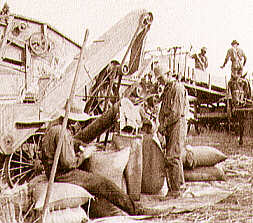When the first pioneers came into the Garfield county area they believed that the land would only be suitable for raising livestock or possibly fruit. The soil grew a type of bunch grass which the settlers believed proved the soil was weak. J. M. Pomeroy, founder of the town of Pomeroy, stated that "the rest of the country would grow only bunch grass and was fit only for grazing. Only a damn fool would think of farming the hills and it would result in the destruction of good cattle range to try what would result in poor farms."1 The settlers "only reason for breaking soil was for garden plots and some grain for flour and hay for their livestock."2 Each farm developed along traditional autonomous lines. Each became a self sufficient entity raising all of their vegetables, fruit, meat and dairy products. Perhaps twice a year the settlers would leave their farms and make the trek to Dayton or Walla Walla for staples such as sugar, tobacco, molasses, corn meal, seeds and metal implements.
Farmers began raising grain in the Palouse to supply their own families and livestock with grain. When the inital crops were harvested the bounty encouraged the farmers to begin planting more acerage to grain. By 1880, according to the U.S. census, Walla Walla County's wheat production rose to 779,907 bushels with a total of 28,770 acres in production. "The Walla Walla Land District was created by an Act of Congress in the spring of 1871. The district embraced all of Washington Territory lying west of the Cascade mountains. In 1876 the district was divided and the Colfax Land District [now known as Whitman county] was created."3
Brute human strength or horse power performed all farm operations before gas powered engines became available. A farmer broke ground with a horse drawn plow which cut and turned the sod. "Grain was usually hand sown and broadcast, then raked or harrowed in. At first, grain was cut with a cradle that was a metal scythe with [a} wood basket to catch the grain."4 "[E. T.] Wilson claims to have threshed the first grain north of the Pataha in 1878 when he threshed 286 bushels of barley. The next year, four threshers were in action nearby and one of them threshed 50,000 bushels of grain."5
By 1880, harvest had become a fully horse powered operation.

Hitches ready for a day in the fields.
Courtesy of the Garfield Country Museum.
As the grain ripened, the farmer moved his harvest crew into the fields. A header cut the grain. The header, a horse powered machine comprised of a sickle bar with a rotating rake, laid the cut stalks on a draper. The draper, a canvas conveyor belt supported by oak slats, ran the cut stalks directly into a header box. The header box was a field wagon with sloping sides drawn by three to four horses. The header box was driven to the stationary thresher located in a central part of the field. Two forkmen pitched the stalks out of the header boxes onto the thresher table.
The stationary thresher separated the grain heads; a worker known as a "sack jig" filled each sack from a spout at the side of the machine.

Sack jigs filling and sewing sacks.
Courtesy Courtesy of the Garfield County Museum.

Sacks being filled at the side of the thresher.
Courtesy Courtesy of the Garfield County Museum.
The sack jig would "jig" or shake the sacks as they filled with grain ensuring a uniform fill on each sack.
The average sack of grain weighed between 138 pounds and 140 pounds. The sack jig passed the open sack of grain to one of two sack sewers who sewed the sack shut. Many teams of jigs and sewers were able to fill and sew two sacks a minute throughout the course of a ten hour day.
Improvements to harvest machinery led to many operations being combined. The header evolved into a machine called a binder that was essentially a header with an attachment that bundled the grain stalks and tied each bundle with twine. These bundles of stalks were left in piles around the field to be picked up by roving teams of forkmen, and put into header boxes. Eventually, the header, binder and thresher united in one machine. This machine was called a combine.

An early combine (notice sack sewers on the side).
Courtesy Courtesy of the Garfield County Museum.
Teams of 12 to 36 horses pulled the first combines. The sack jig and sack sewers worked on a platform on the side of the combine filling sacks of grain.
1. Ewart Baldwin. A History of Garfield County. Oregon, (by the author. 1989). 84.
2. ibid.
3. Frank T. Gilbert. Historic Sketches, Walla Walla, Whitman, Columbia and Garfield Counties, Washington Territory, (Portland, OR: A.G. Walling, 1882). 291-292.
4. Ewart Baldwin. A History of Garfield County. Oregon, (by the author. 1989). 85.
5. ibid., 84.
Introduction
Geography
• Farming
• Transportation
• Grain Chutes
• Mayview Tramway
Bulk Handling
• Conclusion
• Bibliography
• Oral Interviews
• Maps
• Illustrations
Acknowledgements
• Comments
![]()